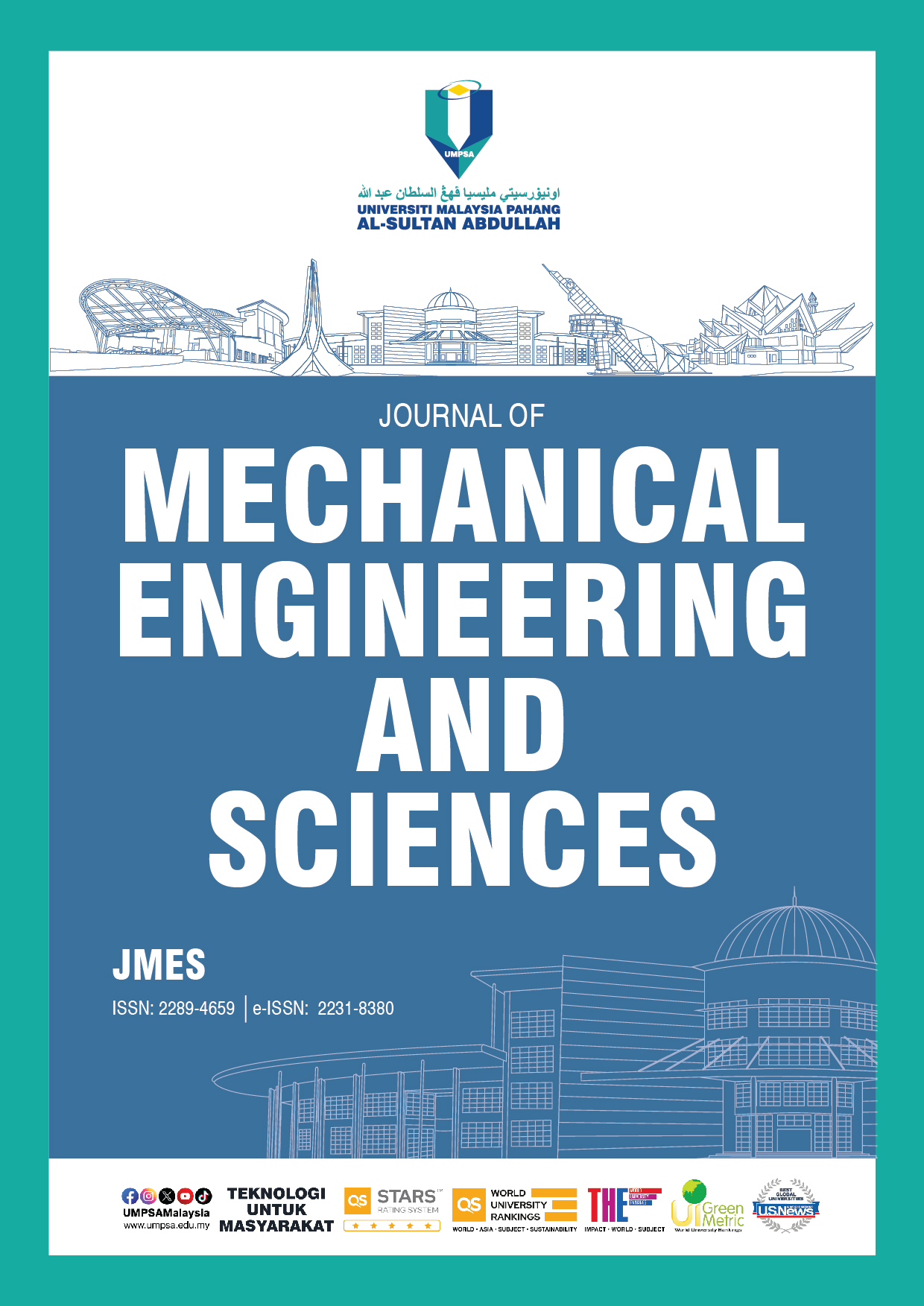Investigation of the aerodynamic effects of bio-inspired modifications on airfoil at low Reynolds number
DOI:
https://doi.org/10.15282/jmes.17.4.2023.5.0769Keywords:
Airfoil, Aerodynamics, Bio-inspired airfoil, CFD, Corrugated, Dragonfly, Low-Reynolds numberAbstract
A numerical study was performed to investigate flow behaviors around bio-inspired modified airfoils compared with NACA 4412 airfoil at Re=5.8x104 by solving the two-dimensional, RANS equations with k-ω STT turbulence model. The obtained results reveal a rather abrupt decrease of lift at stall for the NACA 4412 airfoil in contrast to the mild stall depicted by the top-modified airfoil. As compared to the experimental results of the profiled airfoil in the literature, the characteristic behavior of the variation in the lift coefficient shows resemblance. It is seen that from the velocity distribution results, fluid flowed smoothly along the streamlined nose of NACA 4412 airfoil until α=4⁰ and streamlines adhered well for both airfoils at low angles (0⁰, 2⁰). Smaller circulation bubbles were noticed to settle in the canyons of the corrugated cross-section of the top-modified airfoil. In the wake region of the modified airfoil, there is no obvious large flow separation or circulation region at low angles of attack. However, the blue regions of the dimensionless velocity over the NACA 4412 airfoil and bottom-modified airfoil were narrower than over the top-modified airfoil. The recirculation zone over the airfoil started to enlarge, and the rolling up of the trailing-edge vortex appeared. After α=12⁰, the adverse pressure gradient on the suction side of the airfoils became more intense. In the wake zones, it was seen that the circulation regions grew remarkably and became largest as the angle of attack rose to α=16⁰, which pointed out increased drag forces of airfoils.
References
S. Kennedy, “Biomimicry/biomimetics: General principles and practical examples,” The Science Creative Quarterly [Online], Accessed: December 2023.Available: https://www.scq.ubc.ca/biomimicrybimimetics-general-principles-and-practical-examples/
N. L. Volstad and C. Boks, “On the use of biomimicry as a useful tool for the industrial designer,” Sustainable Development, vol. 20, no. 3, pp. 189–199, 2012.
P. C. Khandelwal and T. L. Hedrick, “Combined effects of body posture and three-dimensional wing shape enable efficient gliding in flying lizards,” Scientific Reports, vol. 12, p. 1793, 2022.
M. Serdar Genç, K. Koca, H. Demir, and H. Hakan Açıkel, “Traditional and new types of passive flow control techniques to pave the way for high maneuverability and low structural weight for UAVs and MAVs,” Autonomous Vehicles, pp. 131-160, 2020.
M. Özden, M. S. Genç, and K. Koca, “Investigation of the effect of hidden vortex generator-flap integrated mechanism revealed in low velocities on wind turbine blade flow,” Energy Conversion and Management, vol. 287, p. 117107, 2023.
X. K. Li, W. Liu, T. J. Zhang, P. M. Wang, and X. D. Wang, “Experimental and numerical analysis of the effect of vortex generator installation angle on flow separation control,” Energies,vol. 12, no. 23, p. 4583, 2019.
R. Jiang et al., “Effect of vortex generator orientation on wind turbines considering the three-dimensional rotational effect,” Ocean Engineering, vol. 267, p. 113307, 2023.
Y. Liu, H. Zhe, Y. Xue, J. Tan, P. Yuan, and Q. Zhang, “Effects of vortex generator on the hydrodynamic characteristics of hydrofoil and horizontal axis tidal turbine,” Physics of Fluids, vol. 35, p. 035104, 2023.
F. R. Marzabadi and M. R. Soltani, “Effect of leading-edge roughness on boundary layer transition of an oscillating airfoil,” Scientia Iranica, vol. 20, no. 3, pp. 508–515, 2013.
M. Serdar Genç, K. Koca, and H. H. Açıkel, “Investigation of pre-stall flow control on wind turbine blade airfoil using roughness element,” Energy, vol. 176, pp. 320–334, 2019.
M. Tamai, J. T. Murphy, and H. Hu, “An experimental study of flexible membrane airfoils at low Reynolds numbers,” 46th AIAA Aerospace Sciences Meeting and Exhibit, Reno, United States, Jan. 7-10, 2008.
P. Rojratsirikul, M. S. Genc, Z. Wang, and I. Gursul, “Flow-induced vibrations of low aspect ratio rectangular membrane wings,” Journal of Fluids and Structures, vol. 27, no. 8, pp. 1296–1309, 2011.
S. Arbós-Torrent, B. Ganapathisubramani, and R. Palacios, “Leading- and trailing-edge effects on the aeromechanics of membrane aerofoils,” Journal of Fluids and Structures,vol. 38, pp. 107–126, 2013.
M. S. Genç, H. H. Açikel, H. Demir, M. Özden, M. Çaǧdaş, and I. Isabekov, “Effect of tip vortices on membrane vibration of flexible wings with different aspect ratios,” in EPJ Web of Conferences, vol. 114, p. 02028, 2016.
M. S. Genç, M. Özden, H. H. Açikel, H. Demir, and I. Isabekov, “Unsteady flow over flexible wings at different low Reynolds numbers,” in EPJ Web of Conferences, vol. 114, p. 02030, 2016.
H. Demir and M. S. Genç, “An experimental investigation of laminar separation bubble formation on flexible membrane wing,” European Journal of Mechanics - B/Fluids, vol. 65, pp. 326–338, 2017.
A. Shahzad, F. B. Tian, J. Young, and J. C. S. Lai, “Effects of flexibility on the hovering performance of flapping wings with different shapes and aspect ratios,” Journal of Fluids and Structures,vol. 81, pp. 69–96, 2018.
H. H. Açıkel and M. Serdar Genç, “Control of laminar separation bubble over wind turbine airfoil using partial flexibility on suction surface,” Energy, vol. 165, pp. 176–190, 2018.
M. S. Genç, H. Demir, M. Özden, and T. M. Bodur, “Experimental analysis of fluid-structure interaction in flexible wings at low Reynolds number flows,” Aircraft Engineering and Aerospace Technology, vol. 93, no. 6, pp. 1060–1075, 2021.
K. Koca, M. S. Genç, E. Bayır, and F. K. Soğuksu, “Experimental study of the wind turbine airfoil with the local flexibility at different locations for more energy output,” Energy, vol. 239, p. 121887, 2022.
S. Roy, A. Biswas, B. Das, and B. V Reddy, “Flow control of a wind-turbine airfoil with a leading-edge spherical dimple,” International Journal of Green Energy,vol. 20, no. 12, pp. 1307–1325, 2023.
J. M. Caram and A. Ahmed, “Effect of riblets on turbulence in the wake of an airfoil,” AIAA Journal, vol. 29, no. 11, pp. 1769–1770, 1991.
Y. Zhang, H. Chen, S. Fu, and W. Dong, “Numerical study of an airfoil with riblets installed based on large eddy simulation,” Aerospace Science and Technology, vol. 78, pp. 661–670, 2018.
Z. Wei, T. H. New, and Y. D. Cui, “An experimental study on flow separation control of hydrofoils with leading-edge tubercles at low Reynolds number,” Ocean Engineering, vol. 108, pp. 336–349, 2015.
C. J. Bai, Y. Y. Lin, S. Y. Lin, and W. C. Wang, “Computational fluid dynamics analysis of the vertical axis wind turbine blade with tubercle leading edge,” Journal of Renewable and Sustainable Energy, vol. 7, no. 3, 2015.
I. K. A. P. Utama et al., “Numerical simulation of foil with leading-edge tubercle for vertical-axis tidal-current turbine,” Journal of Mechanical Engineering and Sciences, vol. 14, no. 3, pp. 6982–6992, 2020.
Y. Zhang et al., “Investigation of aerodynamic forces and flow field of an H-type vertical axis wind turbine based on bionic airfoil,” Energy, vol. 242, p. 122999, 2022.
M. Fan, Z. Sun, X. Dong, and Z. Li, “Numerical and experimental investigation of bionic airfoils with leading-edge tubercles at a low-Re in considering stall delay,” Renewable Energy,vol. 200, pp. 154–168, 2022.
S. Roy, B. Das, and A. Biswas, “A comprehensive review of the application of bio-inspired tubercles on the horizontal axis wind turbine blade,” International Journal of Environmental Science and Technology, vol. 20, no. 4, pp. 4695–4722, 2023.
K. L. Hansen, R. M. Kelso, and B. B. Dally, “Performance variations of leading-edge tubercles for distinct airfoil profiles,” AIAA Journal, vol. 49, no. 1, pp. 185–194, 2011.
J. Wang, T. Nakata, and H. Liu, “Development of mixed flow fans with bio-inspired grooves,” Biomimetics,vol. 4, no. 72, pp. 1-19, 2019.
S. Huang, H. Qiu, and Y. Wang, “Aerodynamic performance of horizontal axis wind turbine with application of dolphin head-shape and lever movement of skeleton bionic airfoils,” Energy Conversion and Management,vol. 267, p. 115803, 2022.
Q. Li, M. Zheng, T. Pan, and G. Su, “Experimental and numerical investigation on dragonfly wing and body motion during voluntary take-off,” Scientific Reports, vol. 8, no. 1, pp. 1–16, 2018.
G. R. Abdizadeh, M. Farokhinejad, and S. Ghasemloo, “Numerical investigation on the aerodynamic efficiency of bio-inspired corrugated and cambered airfoils in ground effect,” Scientific Reports, vol. 12, no. 1, pp. 1–19, 2022.
J. T. Murphy and H. Hu, “An experimental study of a bio-inspired corrugated airfoil for micro air vehicle applications,” Experiments in fluids,vol. 49, no. 2, pp. 531–546, 2010.
M. Tamai, W. Zhijian, G. Rajagopalan, H. Hui, and H. Guowei, “Aerodynamic performance of a corrugated dragonfly airfoil compared with smooth airfoils at low reynolds numbers,” in Collection of Technical Papers-45th AIAA Aerospace Sciences Meeting, pp. 5800–5811, 2007.
H. Hui and M. Tamai, “Bioinspired corrugated airfoil at low Reynolds numbers,” Journal of Aircraft, vol. 45, no. 6, pp. 2068–2077, 2008.
A. Shahzad, H. R. Hamdani, and A. Aizaz, “Investigation of corrugated wing in unsteady motion,” Journal of Applied Fluid Mechanics, vol. 10, no. 3, pp. 833–845, 2017.
Y. D. Dwivedi, S. Y. B. Sudhir, B. Sunil, C. H. V. K. N. S. N. Moorthy, and K. V. Allamraju, “Numerical study of bio-inspired corrugated airfoil geometry in a forward flight at a low Reynolds number,” WSEAS Transactions on Fluid Mechanics, vol. 17, pp. 119–127, 2022.
P. Sooraj and A. Agrawal, “Passive flow control mechanism in a bio-inspired corrugated hydrofoil,” SN Applied Sciences, vol. 1, no. 11, pp. 1–17, 2019.
M. E. Abd El-Latief, K. Elsayed, and M. Madbouli Abdelrahman, “Aerodynamic study of the corrugated airfoil at ultra-low Reynolds number,” Advances in Mechanical Engineering, vol. 11, no. 10. pp. 1–18, 2019.
M. Kharati-koopaee and M. Fallahzadeh-abarghooee, “Effect of corrugated skins on the aerodynamic performance of the cambered airfoils,” Engineering Computations, vol. 35, no. 3, pp. 1567–1582, 2018.
R. R. Harbig, J. Sheridan, and M. C. Thompson, “Reynolds number and aspect ratio effects on the leading-edge vortex for rotating insect wing planforms,” Journal of Fluid Mechanics, vol. 717, pp. 166–192, 2013.
T. J. Flint, M. C. Jermy, T. H. New, and W. H. Ho, “Computational study of a pitching bio-inspired corrugated airfoil,” International Journal of Heat and Fluid Flow, vol. 65, pp. 328–341, 2017.
A. Vargas, R. Mittal, and H. Dong, “A computational study of the aerodynamic performance of a dragonfly wing section in gliding flight,” Bioinspiration & Biomimetics, vol. 3, no. 2, p. 26004, 2008.
A. B. Kesel, “Aerodynamic characteristics of dragonfly wing sections compared with technical aerofoils,” Journal of Experimental Biology, vol. 203, no. 20, pp. 3125–3135, 2000.
H. Demir and B. Kaya, “A study on aerodynamic performance of airfoil in ground effect,” in 8thInternational Asian Congress on Contemporary Sciences, Aksaray, Turkiye, May 5-7, 2023.
I. Karasu, M. Özden, and M. S. Genç, “Performance assessment of transition models for three-dimensional flow over NACA4412 wings at low Reynolds numbers,” Journal of Fluids Engineering, vol. 140, no. 12, p. 121102, 2018.
Downloads
Published
Issue
Section
License
Copyright (c) 2023 The Author(s)

This work is licensed under a Creative Commons Attribution-NonCommercial 4.0 International License.






